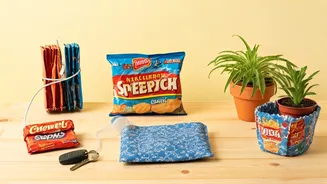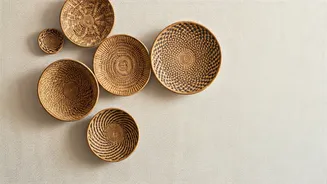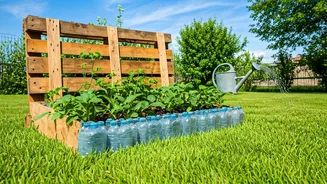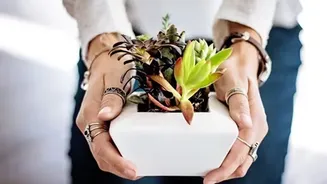Cable Holder Creation
Empty chip packets can be ingeniously transformed into effective cable organizers. The foil lining inside the packets provides a degree of rigidity and
moisture resistance, making them ideal for this purpose. To begin, thoroughly clean and dry the packets. Next, flatten the packet and cut it into a suitable shape; rectangles or squares are usually best, depending on your cable storage needs. Using tape or glue, fold and secure the packet pieces to create small, sturdy holders. For added durability, consider layering multiple packets. These makeshift organizers can be used to neatly bundle and label cables, preventing tangles and keeping your workspace tidy. This method is a cost-effective and sustainable approach to cable management.
Drawer Organizer Designs
Chip packets make excellent materials for DIY drawer organizers, helping to bring order to cluttered drawers. The packets' flexibility allows them to be cut, shaped, and configured to fit various drawer sizes and needs. Start by measuring the inside dimensions of your drawers. Then, cut and fold the chip packets to create compartments of various sizes, suited for items such as pens, stationery, or small tools. Secure the folded edges with glue or tape to ensure the compartments hold their shape. For added aesthetic appeal, the exterior of the packets can be covered with decorative paper or fabric. This approach to organization is not only practical but also provides an opportunity to reduce waste and create a more organized living space.
Travel Snack Bag DIY
Upcycling chip packets is a great way to craft reusable snack bags perfect for travel. The material's moisture-resistant properties are especially advantageous for containing food items. Begin by thoroughly cleaning and drying the packets. Then, cut and fold the packets into the desired bag shape, typically rectangular or square. You can seal the edges using tape, glue, or, for a more durable solution, consider using a heat sealer to create a waterproof seal. These bags can then be used to store snacks and other small essentials, minimizing the need for disposable plastic bags and reducing environmental impact. You may even decorate the exterior of the packets using colorful markers or stickers.
Plant Pot Liner Creation
Chip packets can be creatively utilized as plant pot liners. Their water-resistant qualities protect the pots and help retain moisture, preventing soil from leaking out. Cut the chip packets to fit the inside of your plant pots, ensuring they line the base and sides. Use tape or glue to secure the liner in place. This not only extends the life of your pots but also reduces the amount of water needed to be added because of the moisture preservation qualities of the lining. Add drainage holes to the base of the liner if needed. The foil lining will act as an extra barrier and prevent the soil from eroding through the pot's drainage holes. This is a simple and useful way to give your plants a boost while recycling your waste.
Wall Pocket Construction
Constructing wall pockets from chip packets offers a handy way to create storage in your home or office. The lightweight nature of the packets makes them ideal for hanging on walls. Begin by cleaning and drying the packets. You can then cut and shape the packets into pockets of your desired size. To create a more sturdy pocket, consider layering multiple packets. To secure the pockets to the wall, you can use strong adhesive tape, small nails, or hooks. The pockets can be used to store various items like pens, keys, letters, or other small accessories, thus decluttering your space. This approach merges practicality with recycling, making it a very clever storage solution. You can also customize their appearance with paint or decorative paper to match the style of your space.










